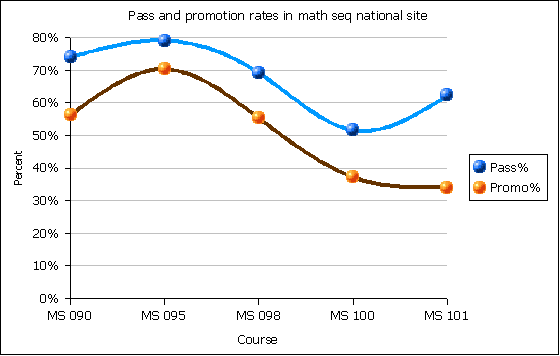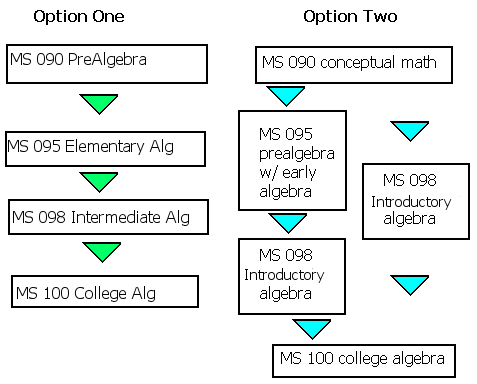

The results of the assessment meeting were as follows. The committee...
The developmental mathematics curriculum was realigned at the college as the result of an assessment meeting on 25 November 2005. At the core of the discussion was the twin issues of students being underprepared for MS 100 College Algebra and a curriculum scope and and sequence gap between MS 098 Transition to Algebra and MS 100 College Algebra. Two options were considered, with option two essentially being a variant of the status quo at that time.


The results of the assessment meeting were as follows. The committee...
 PreAlgebra by Tom Carson
PreAlgebra by Tom Carson
Chapter 1. Whole Numbers Introduction to Numbers, Notation, and Rounding. Adding, Subtracting, and Solving Equations with Whole Numbers. Multiplying Whole Numbers and Exponents. Dividing, Square Roots, and Solving Equations with Whole Numbers. Order of Operations. Variables, Formulas, and Solving Equations. More with Problem Solving and Applications.
Chapter 2. Integers Introduction to Integers. Adding Integers. Subtracting Integers and Solving Equations. Multiplying, Dividing, and Solving Equations with Integers. Order of Operations. Applications and Problem Solving.
Chapter 3. Expressions and Polynomials Evaluating Expressions. Introduction to Polynomials. Simplifying Polynomials. Adding and Subtracting Polynomials. Multiplying Polynomials Prime Numbers and GCF. Introduction to Factoring. Applications and Problem Solving.
Chapter 4. Equations Equations and Their Solutions. The Addition/Subtraction Principle of Equality. The Multiplication/Division Principle of Equality. Translating Word Sentences to Equations. Applications and Problem Solving.
Chapter 5. Fractions and Rational Expressions Fractions, Mixed Numbers, and Rational Expressions. Simplifying Fractions and Rational Expressions. Multiplying Fractions, Mixed Numbers, and Rational Expressions. Dividing Fractions, Mixed Numbers, and Rational Expressions. Least Common Multiple. Adding and Subtracting Fractions, Mixed Numbers, and Rational Expressions. Order of Operations and Evaluating and Simplifying Expressions. Solving Equations .
Chapter 6. Decimals Decimals and Rational Numbers. Adding and Subtracting with Decimals and Solving Equations. Multiplying Decimal Numbers; Exponents with Decimal Bases. Dividing and Roots with Decimals. Order of Operations and Applications in Geometry. Solving Equations and Problem Solving .
Chapter 7. Ratios, Proportions, and Measurement Ratios, Probability, and Rates. Proportions. American Measurement. Metric Measurement. Converting Between the American and Metric Systems. Applications and Problem Solving .
Chapter 8. Percents Introduction to Percent. Translating Percent Sentences Word-for-Word. Translating Percent Sentences to Proportions. Solving Percent Problems (Portions). Solving Problems Involving Percent of Increase or Decrease. Solving Problems Involving Interest.
Chapter 9. Statistics and Graphs Mean, Median, and Mode. Tables, Charts, and Graphs. The Rectangular Coordinate System. Graphing Linear Equations. Applications with Graphing.
 Elementary and Intermediate Algebra, Tom Carson
Elementary and Intermediate Algebra, Tom Carson
1. Foundations of Algebra.
Number Sets and the Structure of Algebra.
Fractions.
Adding and Subtracting Real Numbers; Properties of Real Numbers.
Multiplying and Dividing Real Numbers; Properties of Real Numbers.
Exponents, Roots, and Order of Operations.
Translating Word Phrases to Expressions.
Evaluating and Rewriting Expressions.
2. Solving Linear Equations and Inequalities.
Equations, Formulas, and the Problem-Solving Process.
The Addition Principle.
The Multiplication Principle.
Applying the Principles to Formulas.
Translating Word Sentences to Equations.
Solving Linear Inequalities.
3. Problem Solving.
Ratios and Proportions.
Percents.
Problems with Two or More Unknowns.
Rates.
Investment and Mixture.
4. Graphing Linear Equations and Inequalities.
The Rectangular Coordinate System.
Graphing Linear Equations.
Graphing Using Intercepts.
Slope-Intercept Form.
Point-Slope Form.
Graphing Linear Inequalities.
Introduction to Functions and Function Notation.
5. Polynomials.
Exponents and Scientific Notation.
Introduction to Polynomials.
Adding and Subtracting Polynomials.
Exponent Rules and Multiplying Monomials.
Multiplying Polynomials; Special Products.
Exponent Rules and Dividing Polynomials.
6. Factoring.
Greatest Common Factor and Factoring by Grouping.
Factoring Trinomials of the Form x² + bx + c.
Factoring Trinomials of the Form ax² + bx + c, where a ≠ 1.
Factoring Special Products.
Strategies for Factoring.
Solving Quadratic Equations by Factoring.
Graphs of Quadratic Equations and Functions.
7. Rational Expressions and Equations.
Simplifying Rational Expressions.
Multiplying and Dividing Rational Expressions.
Adding and Subtracting Rational Expressions with the Same Denominator.
Adding and Subtracting Rational Expressions with Different Denominators.
Complex Rational Expressions.
Solving Equations Containing Rational Expressions.
Applications with Rational Expressions.
8. More on Inequalities, Absolute Value, and Functions.
Compound Inequalities.
Equations Involving Absolute Value.
Inequalities Involving Absolute Value.
Functions and Graphing.
Function Operations.
9. Systems of Equations.
Solving Systems of Linear Equations Graphically.
Solving Systems of Linear Equations by Substitution.
Solving Systems of Linear Equations by Elimination.
Solving Systems of Linear Equations in Three Variables.
Solving Systems of Linear Equations Using Matrices.
Cramer's Rule.
Solving Systems of Linear Inequalities.
10. Rational Exponents, Radicals, and Complex Numbers.
Radical Expressions and Functions.
Rational Exponents.
Multiplying, Dividing, and Simplifying Radicals.
Adding, Subtracting, and Multiplying Radical Expressions.
Rationalizing Numerators and Denominators of Radical Expressions.
Radical Equations and Problem Solving.
Complex Numbers.
11. Quadratic Equations.
Completing the Square.
Solving Quadratic Equations Using the Quadratic Formula.
Solving Equations That Are Quadratic in Form.
Graphing Quadratic Functions.
Solving Nonlinear Inequalities.
12. Exponential and Logarithmic Functions.
Composite and Inverse Functions.
Exponential Functions.
Logarithmic Functions.
Properties of Logarithms.
Common and Natural Logarithms.
Exponential and Logarithmic Equations with Applications.
13. Conic Sections.
The Parabola and the Circle.
Ellipses and Hyperbolas.
Nonlinear Systems of Equations.
Nonlinear Inequalities and Systems of Inequalities.